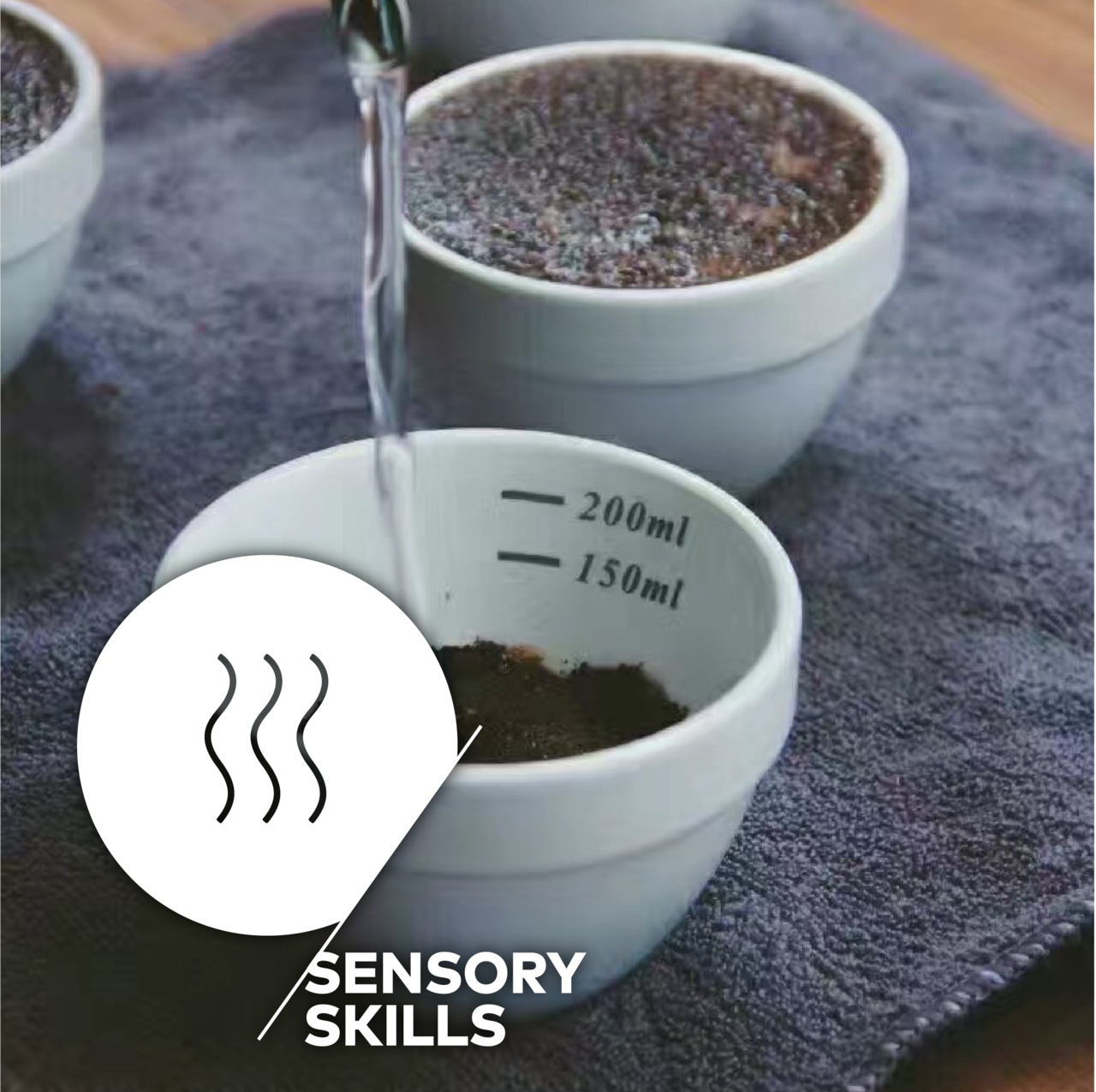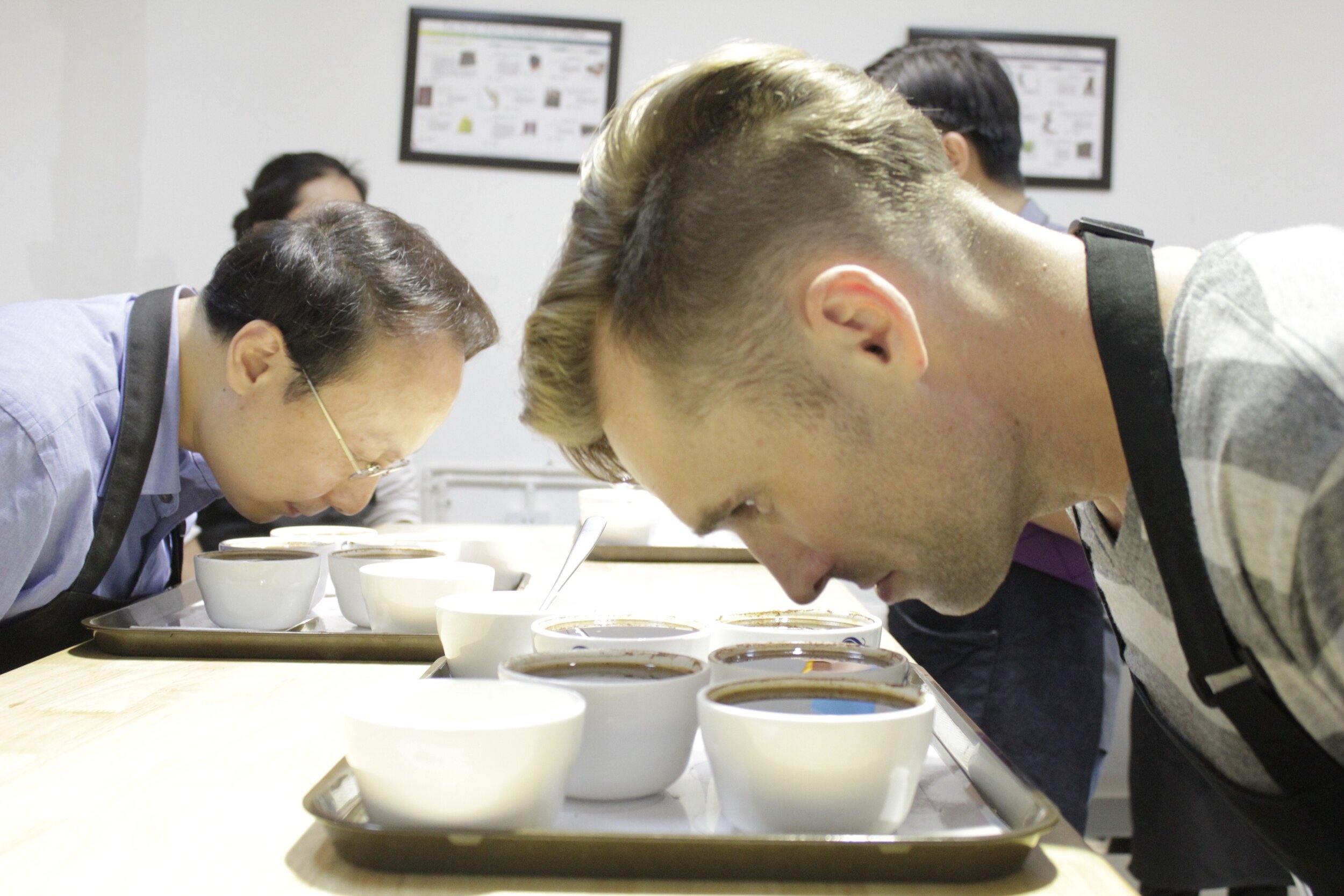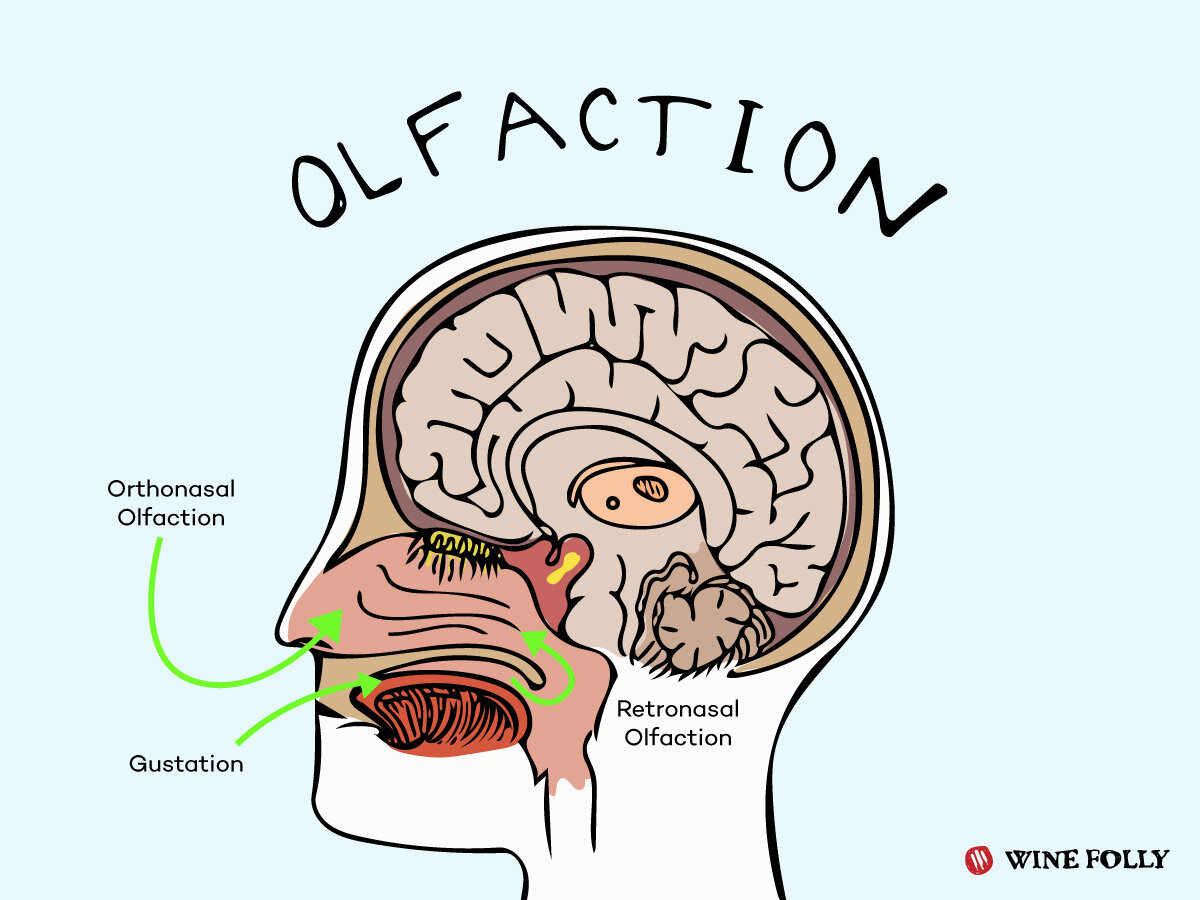How do we find “Flavor Notes” in coffee?
Distinguishing: fragrance, aroma, taste and flavor.
How do I improve my sensory skills?
These are 3 of the most common questions I am asked, in and out of the coffee classroom. In this post, we’ll answer these 3 questions while expanding the discussion. For some coffee fans, this may feel like information overload. For other coffee pros, this may be a good primer to whet your appetite for the SCA Sensory Skills Foundations course. Either way, we will learn and grow together!
Read to the end for my in depth YouTube explanation of the Counter Culture Flavor Wheel!
Humans are the “tool” used to evaluate flavor.
Yes, that’s right. Your nose and mouth work in coffee science.
All scientific inquiry (coffee tasting will be our study) begins with asking a clear question. Our question: “What is the flavor of this coffee?” For coffee professionals “flavor” is a loaded word. It encapsulates fragrance (the dry coffee smell) with aroma (the wet coffee smell) with the taste (how the coffee drinks).
Since the human nose, tongue and mouth are the “tools” used to perform this experiment we must understand that the signals produced and translated by your unique nervous system will be subjective in nature. You have a unique upbringing, with unique exposure to food and drink with myriad fragrances and aromas. You have learned to interpret those signals with language. You personally enjoy some fragrances, aromas and tastes in a different way than another coffee fan or professional does. If performed alone, your sensory perception is less trustworthy given these subjective (even unconscious) biases.
Statistical value and strength is added when multiple people smell and taste the same coffee and find agreement about its attributes. A more robust study, provides a greater degree of trust in the results. By sampling coffees across a group of people, we can reduce or remove the individual biases attributed. That’s a good thing and brings us closer to objective measurements. Remember coffee is loaded with countless subtle characteristics. While, we can’t fully declare that there are wrong sensory conclusions, we can identify that some conclusions are less prominent and that others are dominant.
PS. Research has often shown that women are more sensitive to sensory cues. So it benefits your study when the gals and guys together are brewing, cupping, and sharing sharing feedback over the same coffee!
What am I sensing?
Olfaction = Smell: the “nose” at work
Gustation = Taste: the taste buds at work
Taction = Touch: the tongue at work
We put it all together for a Tasting Note!
Olfaction is Smell
When we bring a dry cup of coffee close to our nose, we begin to smell it’s sweet, floral, fruity, nutty, roasty character. The volatile chemicals bursting from the fresh roasted grounds enter our nose and reach the olfactory bulb. This bulb is filled with sensors that interpret the chemical signals and send electrical pulses to our brain and nervous system. This is how we recognize the difference between peanut butter and smoke or strawberries and fresh cut grass. Each gives off a unique aromatic chemical compound.
Most commonly we think of orthonasal olfaction - smelling things in front of our nose. But another aspect we must bear in mind is retronasal olfaction. When you swallow your coffee, a burst of air rebounds on the back of your tongue and in your throat for a second gust of aroma. That’s why kids who don’t like to eat their vegetables hold their nose before biting and don’t let go until they have swallowed.
Guess what! Those same chemicals are present, roasted into being or roasted (transformed) out of our coffee at various stages. They may emerge only when ground super fresh and disappear after sitting for a few weeks in the bag.
Pro tip: coffee does not taste like strawberries, it tastes like coffee. But some coffee sure has a strong fruity aromatic resemblance with strawberry!
Credit to Wine Folly for this easy diagram. Thanks! https://winefolly.com/deep-dive/science-of-wine-tasting/
Gustation is Taste
“Taste” is a rather broad term. Here we bring it back to its most basic form. The human tongue is a rather simple tool. Used mostly for survival in the process of consuming foods. The sensations of the tongue distinguish (from least sensitive to most): Sweetness, Saltiness, Sourness, and Bitterness. Let’s break these down..
The least sensitive sensation of gustation is sweetness. Many people are able to consume copious amounts of sugar and sweetness without their brain giving warning signals. We neither fear it, nor tire too easily of it.
The next gustatory sensation that is a bit more sensitive is saltiness. While we do enjoy salt (in the right proportions) we cannot tolerate spoon fulls of it, like we can sugar. Too much salt wears down the tongue and causes some adverse side effects if consumed over long periods of time.
Even more sensitive is sourness. This taste sensation begins to turn on our warning lights. As we gustate old-spoiled milk (which was once fresh and sweet) that has become sour we immediately spit it out. Something tells us - this is wrong! Spoiled foods go sour. Drop a splash of white vinegar in your friends water and see what they say. Try again with a pinch of sugar and they likely will not notice.
Humans are most sensitive to bitterness. The last taste is very common to coffee. When someone slides you a REALLY dark roasted coffee you immediately think, “wow! that’s bitter”. Bitterness is present in carbon. Carbon is dangerous for us and many claim it is carcinogenic… thus avoiding grilled foods. Slide a black cup of coffee to a toddler (let’s just imagine ; ) and they’ll immediately spit it out. Bitterness is the taste of caffeine, which is a drug that kids do not accept by taste. Almost every drug from the pharmacy tastes bitter because the chemicals in them are dangerous. Eat a jar of sugar and have an upset stomach. Please don’t eat a jar of pills (or even coffee beans).
Gustation is very very simple. Lao Tzu, in “The Art of War” understood this 2,500 years ago,
“There are not more than five cardinal tastes (sour, acrid, salt, sweet, bitter), yet combinations of them yield more flavors than can ever be tasted.”
PS. “acrid” is like a harsh salt taste. Perhaps this was also an attempt at naming “umami”?
Taction (Tactile) is Touch
The final part of our equation is found in your sense of touch. When we bring the coffee to our lips we feel it’s temperature. This can be pleasant, painful, or disappointing. Next, if it’s not too hot, we feel the coffee on our tongue. It may be heavy (like cream or milk) or it may be light (like tea or water). Perhaps the feeling of the coffee is somewhere between (smooth, rich, silky). We call this mouthfeel and it can be an important attribute on tasting notes or descriptors.
The coffee may coat your tongue in a sticky manner creating a long lasting flavor sensation. Does the flavor linger long or disappear? As you swallow (gustation carried through) the coffee then you may have this combined sensation of aftertaste. This is in part a retro-nasal action, but it is also in part the tactile sensation of your tongue, mouth and throat being coated with coffee.
Pro Tip: when we aspirate and slurp our coffees we accomplish 2 important things.
One - we vaporize the aromas in the coffee for more olfactory stimulation.
Two - we spray the coffee across the mouth for greater taste and tactile sensations.
Now you go try!
How to grow in sensory skills!
If you made it this far, good work. You likely want me to get to the good stuff and tell you the quick and easy way that you can master the art of sensory perception in coffee. Right?
I wish it was as easy as a simple lesson. However, like all good skills - coffee sensory analysis requires practice. But as long as you’re putting in the work - let’s be sure to practice the right things. Here goes:
My list for ways to grow in coffee sensory analysis:
Practice smelling and tasting on a light or empty stomach. A full stomach dulls the senses. If you must eat, try a banana, apple or toast.
In the same logic as above, test your coffee or perform cupping early in the day. By night time your body and senses are tired and less receptive.
Eat and drink more slowly. Chew longer. Drink slowly. These sensory habits will certainly lead to better health habits as well.
Get a good night sleep. Make sure you’re not feeling sick. Lack of sleep and sickness often lead to dulled senses and/or upset stomach. If any symptoms like this exist your body will be more focus on healing and preservation than enjoying sensory stimulation.
If you have sinus problems or a stuffed nose, do blow it. Having clear sinuses will help you perceive what you smell.
Alternatively, do you have a dry nose? Take a cup of hot water and just breath in the warm steam. By warming and wetting your nasal cavity you will increase the sensitivity to aroma and fragrance. This is the same reason a healthy dog has a wet nose and why other dogs will lick their noses - it increases sensitivity to smell.
Avoid drinking too much coffee before sensory work. The more caffeine you ingest the less sensitive you are to the next cup of coffee. Your pallet and tongue also become fatigued.
Avoid soap or lotions with perfumes. Go perfume neutral and ensure that the room you are in is free of candles or other strong smells.
Learn to attend to your senses all day long. As you go through the day you need to catalogue all of the fragrances and aromas you encounter. Sensory analysis works because your brain has a library to draw from. As you record experiences daily - your library grows and you quickly know how to recall and name what you sense. Every moment can lead you to mastery. Read on:
Daily Olfaction: When you walk into a new room, stop to notice the fragrances present. It is hairspray or perfume? Old furniture or leather? Etc. When you eat a meal, every meal, stop and ask what am I really smelling? Can I recognize any spices or seasonings?
Daily Gustation: Isolate flavors in your drinks. How sweet or sour are they? Are there different levels and combinations of taste sensations? When you drink water is it slightly salty or sweet (perhaps mineralized) or do you recognize odd taints in it (like in city water)?
Try reducing or eliminating sugar for a few days. After it has been removed, slowly reintroduce it in small amounts. You will find your sensitivity has increased. Do the same for salt if you have a high salt diet. I did this in China for a few weeks. I ate plain boiled oats for breakfast. I cut out all soda, snacks and sugary treats. Later adding just a few raisins to my oats made me feel like a king! : )
Isolate sensations. When you know what sugar feels like (not tastes like) then find that feeling in a nice light roasted black coffee. Recognize sour in a lemon and then find it in your light roast. If your grocery store has tonic water get some unsweetened. Or if you have an Asian market nearby, look for bitter melon (it looks like a long bumpy cucumber). Once you can isolate sensations, then you can also recognize them when stirred together. When you have a sweetened tonic water you can taste the sweet and bitter at work together on your tongue.
Plan extra time at the grocery store. Spend 15 minutes in the produce section smelling the vegetables. Fruit and veggies have great attributes you can smell (especially if organic and fresh). Try the live spice section. Then head over to the dry spice section and bulk food section. Smell and categorize everything, but be discrete of course ; )
Use a Coffee Tasters Flavor Wheel. The New SCA Flavor Wheel, the Old SCA Flavor Wheel and the Counter Culture Flavor Wheel are all super useful and you can grab them via these links. Work from general to specific - from inside to the outside. For example when a coffee smells sweet is it floral or chocolate or fruit sweet? You identify it’s like fruit so is it a red fruit or tropical fruit or citrus fruit. It’s a citrus fruit sweetness. Maybe you just stop there with your tasting notes. Well Done! Or perhaps you go further and say, it’s a little sweet and tart like a grapefruit. Lemons are not so sweet, but oranges are far too sweet. Perfect! Using process of elimination working from general to specific is the way to go.
Try the rigorous experiments in the Coffee Lexicon by the World Coffee Research, or head back to the the grocery store. Perhaps it’s time to pick up some milk chocolate, dark chocolate and bakers chocolate… for scientific research of course ; ) While you’re at it grab a good variety of unroasted and unsalted nuts if available from the bulk section.
Finally, have fun. Don’t compare yourself to “the pros”. Many coffee people (myself in the past) may feel bold and make great declarations about wild tasting notes. Just say, “oh that’s nice. I don’t taste marmalade and sassafras root, it’s just sweet and spicy to me.” Perfect! Smile and keep honing your skills.
A joyful brain is a growing brain.
Enjoy the Sensory Journey my friends! If you’d like to learn more and try getting certified with the Specialty Coffee Association, then I developed a course for you!
Insert plug with link for Sensory Foundations course : )
Let’s Review.
How do we find “flavor notes” in coffee?
How do we differentiate all that goes into a “flavor note”?
And, how do we grow in our coffee sensory skills?
If you can’t answer, or begin to practice, these 3 above then please reach out and let me know what questions you have. I enjoy hearing from friends and students in my courses and look forward to helping you on the path to coffee mastery.



